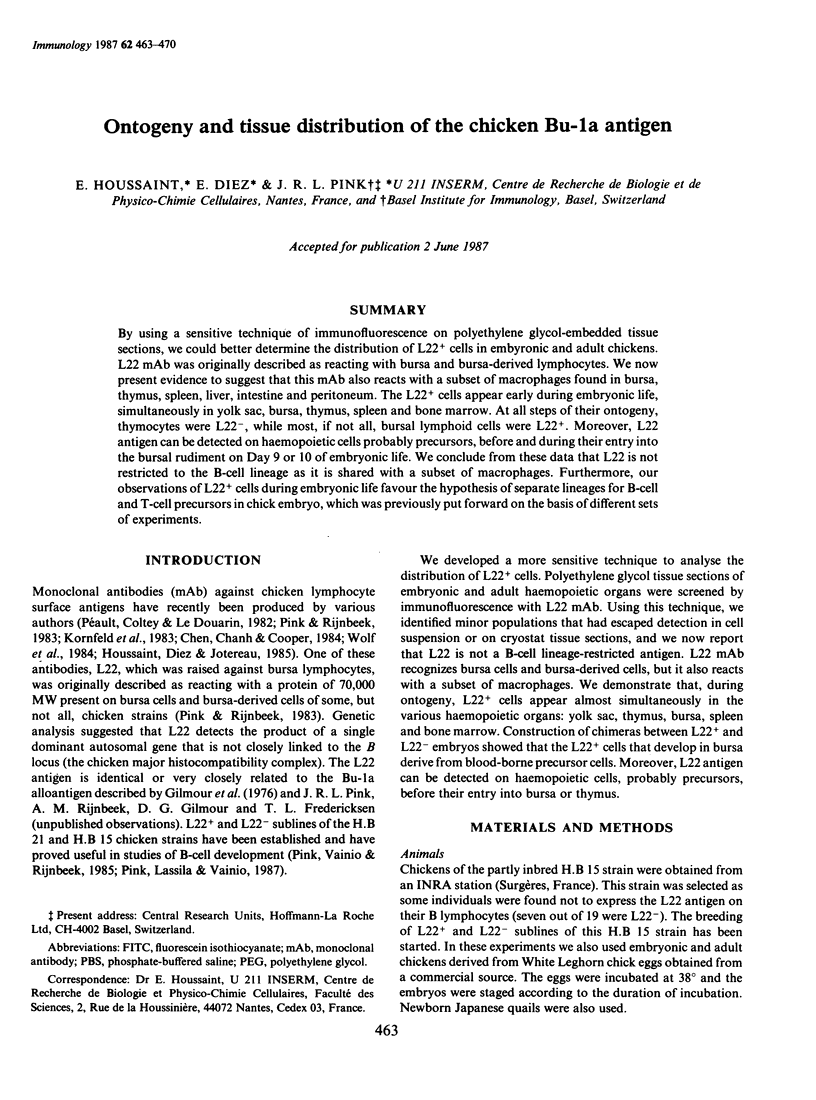Ontogeny and tissue distribution of the chicken Bu-1a antigen (original) (raw)
. 1987 Nov;62(3):463–470.
Abstract
By using a sensitive technique of immunofluorescence on polyethylene glycol-embedded tissue sections, we could better determine the distribution of L22+ cells in embryonic and adult chickens. L22 mAb was originally described as reacting with bursa and bursa-derived lymphocytes. We now present evidence to suggest that this mAb also reacts with a subset of macrophages found in bursa, thymus, spleen, liver, intestine and peritoneum. The L22+ cells appear early during embryonic life, simultaneously in yolk sac, bursa, thymus, spleen and bone marrow. At all steps of their ontogeny, thymocytes were L22-, while most, if not all, bursal lymphoid cells were L22+. Moreover, L22 antigen can be detected on haemopoietic cells probably precursors, before and during their entry into the bursal rudiment on Day 9 or 10 of embryonic life. We conclude from these data that L22 is not restricted to the B-cell lineage as it is shared with a subset of macrophages. Furthermore, our observations of L22+ cells during embryonic life favour the hypothesis of separate lineages for B-cell and T-cell precursors in chick embryo, which was previously put forward on the basis of different sets of experiments.

Images in this article
Selected References
These references are in PubMed. This may not be the complete list of references from this article.
- Boggs D. R., Boggs S. S., Saxe D. F., Gress L. A., Canfield D. R. Hematopoietic stem cells with high proliferative potential. Assay of their concentration in marrow by the frequency and duration of cure of W/Wv mice. J Clin Invest. 1982 Aug;70(2):242–253. doi: 10.1172/JCI110611. [DOI] [PMC free article] [PubMed] [Google Scholar]
- Chen C. H., Chanh T. C., Cooper M. D. Chicken thymocyte-specific antigen identified by monoclonal antibodies: ontogeny, tissue distribution and biochemical characterization. Eur J Immunol. 1984 May;14(5):385–391. doi: 10.1002/eji.1830140502. [DOI] [PubMed] [Google Scholar]
- Dieterlen-Lièvre F., Martin C. Diffuse intraembryonic hemopoiesis in normal and chimeric avian development. Dev Biol. 1981 Nov;88(1):180–191. doi: 10.1016/0012-1606(81)90228-1. [DOI] [PubMed] [Google Scholar]
- Drews U. Cholinesterase in embryonic development. Prog Histochem Cytochem. 1975;7(3):1–52. [PubMed] [Google Scholar]
- Ewert D. L., Munchus M. S., Chen C. L., Cooper M. D. Analysis of structural properties and cellular distribution of avian Ia antigen by using monoclonal antibody to monomorphic determinants. J Immunol. 1984 May;132(5):2524–2530. [PubMed] [Google Scholar]
- Guillemot F. P., Oliver P. D., Peault B. M., Le Douarin N. M. Cells expressing Ia antigens in the avian thymus. J Exp Med. 1984 Dec 1;160(6):1803–1819. doi: 10.1084/jem.160.6.1803. [DOI] [PMC free article] [PubMed] [Google Scholar]
- Houssaint E. Cell lineage segregation during bursa of Fabricius ontogeny. J Immunol. 1987 Jun 1;138(11):3626–3634. [PubMed] [Google Scholar]
- Houssaint E., Diez E., Jotereau F. V. Tissue distribution and ontogenic appearance of a chicken T lymphocyte differentiation marker. Eur J Immunol. 1985 Mar;15(3):305–308. doi: 10.1002/eji.1830150319. [DOI] [PubMed] [Google Scholar]
- Houssaint E., Tobin S., Cihak J., Lösch U. A chicken leukocyte common antigen: biochemical characterization and ontogenetic study. Eur J Immunol. 1987 Feb;17(2):287–290. doi: 10.1002/eji.1830170221. [DOI] [PubMed] [Google Scholar]
- Houssaint E., Toraño A., Ivanyi J. Ontogenic restriction of colonization of the bursa of Fabricius. Eur J Immunol. 1983 Jul;13(7):590–595. doi: 10.1002/eji.1830130715. [DOI] [PubMed] [Google Scholar]
- Johnson G. D., Davidson R. S., McNamee K. C., Russell G., Goodwin D., Holborow E. J. Fading of immunofluorescence during microscopy: a study of the phenomenon and its remedy. J Immunol Methods. 1982 Dec 17;55(2):231–242. doi: 10.1016/0022-1759(82)90035-7. [DOI] [PubMed] [Google Scholar]
- Kornfeld S., Beug H., Doederlein G., Graf T. Detection of avian hematopoietic cell surface antigens with monoclonal antibodies to myeloid cells. Their distribution on normal and leukemic cells of various lineages. Exp Cell Res. 1983 Feb;143(2):383–394. doi: 10.1016/0014-4827(83)90065-4. [DOI] [PubMed] [Google Scholar]
- Lydyard P. M., Grossi C. E., Cooper M. D. Ontogeny of B cells in the chicken. I. Sequential development of clonal diversity in the bursa. J Exp Med. 1976 Jul 1;144(1):79–97. doi: 10.1084/jem.144.1.79. [DOI] [PMC free article] [PubMed] [Google Scholar]
- Peault B., Coltey M., Le Douarin N. M. Tissue distribution and ontogenetic emergence of differentiation antigens on avian T cells. Eur J Immunol. 1982 Dec;12(12):1047–1050. doi: 10.1002/eji.1830121211. [DOI] [PubMed] [Google Scholar]
- Pink J. R., Rijnbeek A. M. Monoclonal antibodies against chicken lymphocyte surface antigens. Hybridoma. 1983;2(3):287–296. doi: 10.1089/hyb.1983.2.287. [DOI] [PubMed] [Google Scholar]
- Pink J. R., Vainio O., Rijnbeek A. M. Clones of B lymphocytes in individual follicles of the bursa of Fabricius. Eur J Immunol. 1985 Jan;15(1):83–87. doi: 10.1002/eji.1830150116. [DOI] [PubMed] [Google Scholar]
- Weber W. T., Alexander J. E. The potential of bursa-immigrated hematopoietic precursor cells to differentiate to functional B and T cells. J Immunol. 1978 Aug;121(2):653–657. [PubMed] [Google Scholar]
- Wolf H., Hála K., Boyd R. L., Wick G. MHC- and non-MHC-encoded surface antigens of chicken lymphoid cells and erythrocytes recognized by polyclonal xeno-, allo- and monoclonal antibodies. Eur J Immunol. 1984 Sep;14(9):831–839. doi: 10.1002/eji.1830140912. [DOI] [PubMed] [Google Scholar]